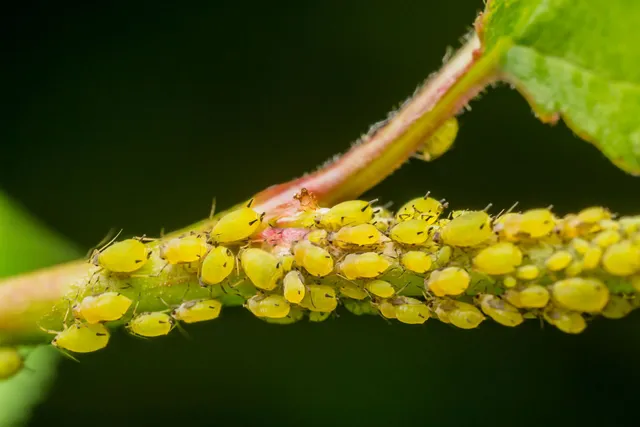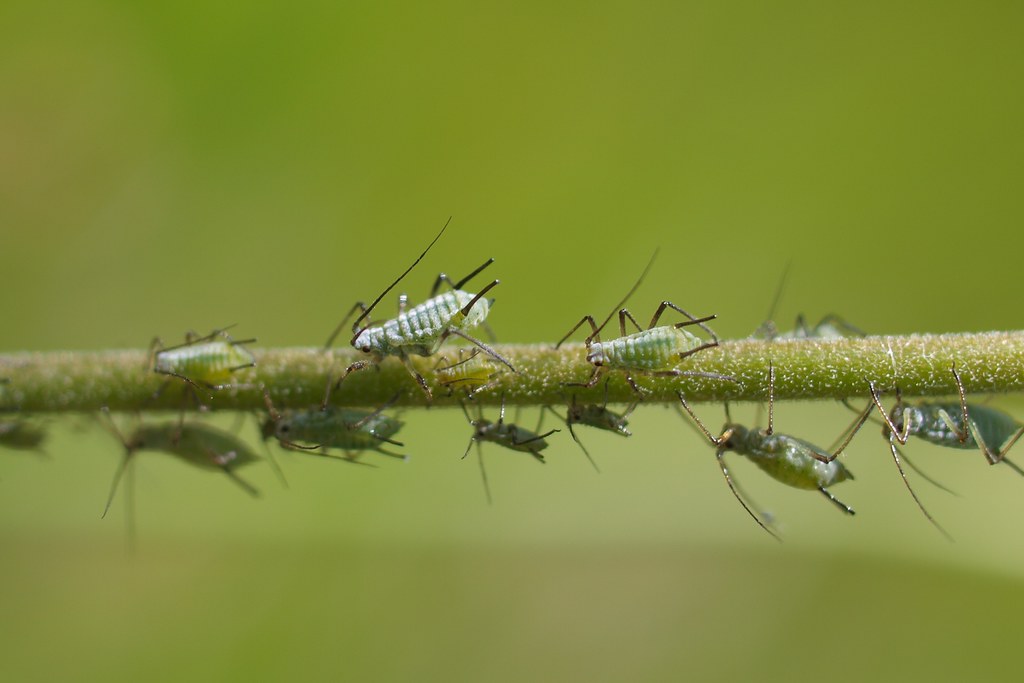Aphids might be tiny, but their impact on our gardens can be massive, and frustrating. While turning to chemical sprays is tempting, we don’t have to trade our health or our soil’s future just to keep our roses and tomatoes safe.
Natural, non-toxic solutions exist. By understanding aphids and using earth-friendly strategies, we can enjoy thriving plants and a vibrant, healthy garden ecosystem.
Let’s explore exactly how to keep aphids away without chemicals.
Understanding Aphids and Their Impact
Aphids are small, soft-bodied insects that cluster on the undersides of leaves, stems, and flower buds. They come in numerous colors, green, black, yellow, and even pink, but all have a voracious appetite for plant juices. As aphids feed, they puncture plant tissues and suck out the sap, weakening our plants and sometimes transmitting viral diseases.
The real trouble comes from their rapid reproduction: a single aphid can give rise to thousands in a single season. As sap is drawn from leaves and stems, our plants may show curling, yellowing, and stunted growth.
Worse,
aphids excrete a sticky substance called honeydew, which can attract ants and encourage the growth of sooty mold, a black fungus that further blocks sunlight. That’s why early, proactive, chemical-free action is so worthwhile.
Identifying Aphid Infestations

Early detection is essential if we want to nip aphid problems in the bud. The first step is to inspect our plants regularly, especially new growth or the undersides of leaves. Aphids may appear as tiny specks, often in clusters, but we’ll also spot their telltale signs:
- Leaves that are distorted, yellowing, or curling
- A sticky glaze (honeydew) coating leaves or dripping onto surfaces below
- The presence of ants crawling up and down stems (they farm aphids for honeydew.)
- Sooty mold, appearing as dark patches on leaves
If we look closely, we may also see cast aphid “skins” (sheddings) around colonies. Catching infestations early lets us act fast, before our plants suffer long-lasting harm.
Natural Predators: Encouraging Beneficial Insects
Nature’s best aphid defense comes with wings or extra legs. Ladybugs, lacewings, hoverflies, and parasitic wasps feed on aphids, sometimes devouring hundreds a day. Instead of reaching for a spray bottle, we can encourage these garden allies:
- Plant a biodiversity buffet: Grow pollen- and nectar-rich flowers, like alyssum, dill, fennel, yarrow, and cosmos, to attract and sustain beneficials all season.
- Go chemical-free: Even “gentle” pesticides harm good bugs. Let’s keep our garden safe for these tiny hunters.
- Provide habitat: Leave small patches of leaf litter, and avoid overly tidy beds to support beneficial larvae and overwintering adults.
Watching a ladybug larvae munch her way through a colony is more satisfying than any commercial spray. With patience, our ecosystem balances and pests get a natural check.
Using Physical Barriers and Manual Removal
Sometimes the simplest solutions are the most effective. There’s no shame in rolling up our sleeves and physically evicting aphids. Here are tried-and-true, chemical-free techniques:
- Water power: Blast aphids off with a strong jet of hose water. Most won’t return, and it’s oddly satisfying.
- Hand-picking: If infestations are small, squash or brush aphids off shoots and buds. A glove or a damp cloth works wonders on delicate stems.
- Sticky traps: Yellow sticky cards attract flying aphids (and some natural enemies, so use sparingly near beneficial insect hotspots).
- Floating row covers: Lightweight fabric barriers prevent aphids from landing on young plants while letting light and air through.
Physical controls are all about persistence. A few minutes a week can save us hours and heartbreak later.
Plant-Based Aphid Control Methods

Plants have been protecting themselves from aphids long before we ever put spade to soil. We can tap into this wisdom in our own gardens:
- Neem oil: This plant-based extract disrupts aphid feeding and reproduction. Dilute according to label directions and spray directly on colonies.
- Essential oils: Peppermint, clove, rosemary, and thyme oils (properly diluted) act as repellents for soft-bodied insects. Always spot-test before widespread use.
- Garlic and onion sprays: Both can deter aphids, as their sulfur compounds and strong odors disorient pests. Chop, steep, strain, and spray for a natural barrier.
We do need to use these treatments carefully, they’re safer than synthetic chemicals, but can affect beneficial insects if applied excessively. Target spraying and evening applications help minimize impact.
Promoting Aphid-Resistant Plants and Companions
Some plants are naturally less appealing to aphids, and others go a step further, they actively protect their neighbors. By planning our planting, we can create garden beds that practically repel pests.
- Aphid-resistant varieties: Look for crops labeled as “aphid-tolerant” or “resistant”, especially among lettuce, cabbage, or beans.
- Companion planting: Pair vulnerable plants with companions like garlic, chives, nasturtiums, or marigolds. Nasturtiums, in particular, lure aphids away from crops, effectively acting as a “trap crop.” Marigolds give off a scent that repels many garden pests, including aphids.
- Diverse plantings: Aphids spread less quickly in mixed flowerbeds than in monocultures. A tapestry of flowers and herbs supports defense and beauty.
By working with plant friendships, we reduce infestations and strengthen our garden’s natural rhythm.
Homemade Sprays and Solutions
There’s something empowering about making our own aphid repellents, right from the kitchen. Here are a few recipes many gardeners swear by:
- Soap spray: Mix 1-2 teaspoons of pure castile (or mild dish) soap per quart of water. Spray directly on aphids, targeting undersides of leaves. The soap dissolves their protective coating, but rinse plants after a few hours to avoid damage.
- Oil spray: Combine 1 tablespoon of vegetable oil with 1 quart water and 1 teaspoon soap. This coats aphids and suffocates them.
- Chili or garlic spray: Blend fresh chilies or several garlic cloves with water: strain and spray the pungent liquid on infested areas.
Test any homemade solution on a small patch before full application. And remember, a quick reapplication every few days, especially after rain, makes a big difference.
Adopting Healthy Gardening Practices
Our best weapon against aphids? A thriving, resilient garden. When plants are healthy, they fend off pests better. Here’s how we stack the odds in our favor:
- Feed the soil: Healthy soil breeds healthy plants. We incorporate compost and organic matter, which boosts vitality and natural resistance.
- Water wisely: Stressed plants attract aphids. We water deeply, at the base, early in the day, helping roots grow strong.
- Prune and clean: Removing infested or overcrowded growth improves air flow and reduces hiding places for pests.
- Rotate crops: Changing planting locations each year interrupts the aphid life cycle and confuses returning adults.
Pairing these good habits with other strategies amplifies our natural pest control efforts, and our garden’s yields.
Conclusion
Living with aphids doesn’t mean surrendering our gardens or relying on harsh chemicals. By watching, planting smart, inviting natural allies, and using a few kitchen concoctions, we can keep these pests in check.
The result?
Healthier plants, safer harvests, and a garden that hums with life instead of languishing in silence.
Let’s keep cultivating, observing, and adjusting, nature gives us everything we need to protect our green spaces, naturally.
Key Takeaways
- Inspect plants regularly for early signs of aphids such as curled leaves and sticky honeydew to act quickly without chemicals.
- Encourage natural predators like ladybugs and lacewings by planting nectar-rich flowers and avoiding pesticides.
- Use physical controls such as blasting aphids with water, hand-picking, and installing floating row covers for effective, chemical-free removal.
- Apply plant-based treatments like neem oil, essential oils, or garlic sprays as safe alternatives to control aphids naturally.
- Promote aphid-resistant varieties, companion planting, and diverse plantings to create an inhospitable environment for aphids.
- Maintain healthy soil, practice proper watering, prune infested growth, and rotate crops to bolster plants’ resistance against aphids without chemicals.
Frequently Asked Questions
What are the best ways to keep aphids away without chemicals?
Some of the best natural ways to keep aphids away without chemicals include introducing beneficial insects, using strong water sprays, applying homemade soap or garlic sprays, and practicing companion planting with aphid-repellent plants like marigolds and chives.
How do I encourage natural predators of aphids in my garden?
Plant nectar-rich flowers such as alyssum, dill, and yarrow to attract ladybugs, lacewings, and hoverflies. Avoid using any pesticides to keep the habitat safe for these natural aphid predators and provide undisturbed spaces like patches of leaf litter.
Can homemade sprays really control aphids without chemicals?
Yes, homemade sprays like diluted castile soap, garlic, onion, or chili sprays can help control aphid populations. Always test these DIY solutions on a small part of your plant first and reapply regularly, especially after rain, for best results.
Which plants naturally repel aphids?
Plants such as garlic, chives, nasturtiums, and marigolds are known to repel aphids. Companion planting these alongside vulnerable crops can deter aphid infestations and create a more resilient garden ecosystem.
Why is regular inspection important for chemical-free aphid control?
Inspection helps detect aphids early, when populations are still small and easier to remove using non-chemical methods. Look for curling leaves, sticky residue, and clustered insects under leaves to catch infestations before significant plant damage occurs.
How often should I apply natural aphid control methods?
Natural aphid control methods like sprays or water jets are most effective when used regularly, typically every few days or after rainfall. Consistent monitoring and timely action help keep aphid numbers down without resorting to chemicals.



